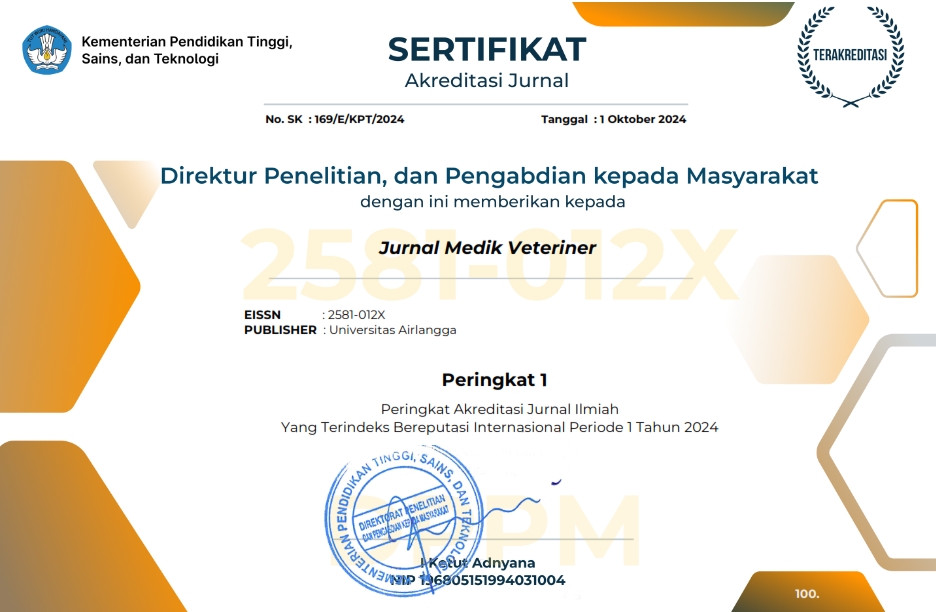Efficacy of Black Cumin (Nigella sativa) Ameliorate Organophosphate Toxicity in Pregnant Rats Based on Progesterone Levels and Fetal Bone Development

Downloads
Black cumin (Nigella sativa), also referred to as black cumin, is a versatile herbal treatment that has recently grown in popularity, it contains antimicrobial, antibacterial, antifungal, anti-inflammatory, analgesic, antipyretic, antiparasitic, antihistamine, antihypertensive, antitumor, anticancer, antidiabetic, and anti-asthmatic properties are just a few of the positive and pharmacological effects of active ingredients in black cumin, such as thymoquinone and other compounds. This study aimed to evaluate black cumin activity ameliorates organophosphate toxicity in pregnant rats based on progesterone levels and fetal bone development. In this study, pregnant albino rats were divided into five treatment groups i.e. (K-) placebo; (K+) treated an organophosphate; treated an organophosphate and black cumin extract at a dose of (P1) 200 mg/kg BW, (P2) 400 mg/kg BW, and (P3) 600 mg/kg BW. The progesterone levels serum and fetal bone development were evaluated and calculated using ANOVA followed by Turkey. The results showed that P2 and P3 groups significantly increase in progesterone levels compared to K+ and P1 groups. Fetal bone was also reported increase in the growth of caudal vertebrae. In conclusion, 400 mg/kg BW of black cumin could ameliorated progesterone levels and fetal bone development in pregnant rats with organophosphate toxicity.
Albores-Garcia, D., McGlothan, J. L., Bursac, Z., & Guilarte, T. R. (2021). Chronic developmental lead exposure increases μ-opiate receptor levels in the adolescent rat brain. Neurotoxicology, 82, 119–129.
Aroniadou-Anderjaska, V., Figueiredo, T. H., Apland, J. P., & Braga, M. F. (2020). Targeting the glutamatergic system to counteract organophosphate poisoning: A novel therapeutic strategy. Neurobiology of Disease, 133, 104406.
Bahari, B. S., Agoeshermadi, H., Fikri, F., Sardjito, T., Purnomo, A., Chhetri, S., Maslamama, S. T., & Purnama, M. T. E. (2023). Efficacy of intra-vulvo submucosal prostaglandins on estrous cycles in goats. Indian Veterinary Journal, 100(4), 24–27.
Benedetti, B., Caponigro, V., & Ardini, F. (2022). Experimental Design Step by Step: A Practical Guide for Beginners. Critical Reviews in Analytical Chemistry, 52(5), 1015–1028.
Brett, K. E., Ferraro, Z. M., Yockell-Lelievre, J., Gruslin, A., & Adamo, K. B. (2014). Maternal-fetal nutrient transport in pregnancy pathologies: the role of the placenta. International Journal of Molecular Sciences, 15(9), 16153–16185.
Chen, K. X., Zhou, X. H., Sun, C. A., & Yan, P. X. (2019). Manifestations of and risk factors for acute myocardial injury after acute organophosphorus pesticide poisoning. Medicine, 98(6), e14371.
Dagg, K., Irish, S., Wiegand, R. E., Shililu, J., Yewhalaw, D., & Messenger, L. A. (2019). Evaluation of toxicity of clothianidin (neonicotinoid) and chlorfenapyr (pyrrole) insecticides and cross-resistance to other public health insecticides in Anopheles arabiensis from Ethiopia. Malaria Journal, 18(1), 49.
Eltigani, A., Müller, A., Ngwene, B., & George, E. (2021). Physiological and Morphological Responses of Okra (Abelmoschus esculentus L.) to Rhizoglomus irregulare Inoculation under Ample Water and Drought Stress Conditions Are Cultivar Dependent. Plants (Basel, Switzerland), 11(1), 89.
Fikri, F., & Purnama, M. T. E. (2020). Pharmacology and phytochemistry overview on Sauropus androgynous. Systematic Reviews in Pharmacy, 11(6), 124–128.
Hamid, I. S., Ekowati, J., & Purnama, M. T. E. (2019). Kaempferia galanga L. inhibiting effect on Vascular Endothelial Growth Factor (VEGF) and cyclooxygenase-2 (Cox-2) expression on endothelium of chorioallantoic membrane. Indian Veterinary Journal, 96(9), 80–82.
Hamid, I. S., Aksono, E. B., Sukmanadi, M., & Purnama, M. T. E. (2018). Antiangiogenesis activity test of tin leaf (Ficus carica L.) on the number of blood vessels and VEGF expression of chorioallantoic membrane of embryonated chicken eggs. European Journal of Oncology Pharmacy, 1(4), e00007.
Hidayatik, N., Purnomo, A., Fikri, F., & Purnama, M. T. E. (2021). Amelioration on oxidative stress, testosterone, and cortisol levels after administration of Vitamins C and E in albino rats with chronic variable stress. Veterinary World, 14(1), 137.
Hosseini, M., Mohammadpour, T., Karami, R., Rajaei, Z., Reza Sadeghnia, H., & Soukhtanloo, M. (2015). Effects of the hydro-alcoholic extract of Nigella sativa on scopolamine-induced spatial memory impairment in rats and its possible mechanism. Chinese Journal of Integrative Medicine, 21(6), 438–444.
Hosseinzadeh, H., Tafaghodi, M., Mosavi, M. J., & Taghiabadi, E. (2013). Effect of aqueous and ethanolic extracts of Nigella sativa seeds on milk production in rats. Journal of Acupuncture and Meridian Studies, 6(1), 18–23.
Kartikasari, A. M., Dewi, C. M. S., Listyasari, N., Pratama, A. R., & Purnama, M. T. E. (2020). Effect of tadpole serum on thyroid hormones and cytotoxic T-cell activity in Wistar rats: a model of skin cancer. Indian Veterinary Journal, 97(6), 34–37.
Khafaga, A. F., Naiel, M. A. E., Dawood, M. A. O., & Abdel-Latif, H. M. R. (2020). Dietary Origanum vulgare essential oil attenuates cypermethrin-induced biochemical changes, oxidative stress, histopathological alterations, apoptosis, and reduces DNA damage in Common carp (Cyprinus carpio). Aquatic toxicology (Amsterdam, Netherlands), 228, 105624.
Kovacs C. S. (2014). Bone development and mineral homeostasis in the fetus and neonate: roles of the calciotropic and phosphotropic hormones. Physiological Reviews, 94(4), 1143–1218.
Li, W. Q., Zhang, J. Y., Ma, J. L., Li, Z. X., Zhang, L., Zhang, Y., Guo, Y., Zhou, T., Li, J. Y., Shen, L., Liu, W. D., Han, Z. X., Blot, W. J., Gail, M. H., Pan, K. F., & You, W. C. (2019). Effects of Helicobacter pylori treatment and vitamin and garlic supplementation on gastric cancer incidence and mortality: follow-up of a randomized intervention trial. BMJ (Clinical research ed.), 366, l5016.
Mahna, D., Puri, S., & Sharma, S. (2018). DNA methylation signatures: Biomarkers of drug and alcohol abuse. Mutation Research. Reviews in Mutation Research, 777, 19–28.
Medvecky, L., Giretova, M., Stulajterova, R., & Kasiarova, M. (2015). Effect of microstructure characteristics on tetracalcium phosphate-nanomonetite cement in vitro cytotoxicity. Biomedical materials (Bristol, England), 10(2), 025006.
Mu, Y., Zhou, X., Liu, L., Zhou, X. K., Zeng, X. C., & Li, W. J. (2019). Pseudaminobacter arsenicus sp. nov., an arsenic-resistant bacterium isolated from arsenic-rich aquifers. International Journal of Systematic and Evolutionary Microbiology, 69(3), 791–797.
Muzolf-Panek, M., Kaczmarek, A., Tomaszewska-Gras, J., Cegielska-Radziejewska, R., Szablewski, T., Majcher, M., & Stuper-Szablewska, K. (2020). A Chemometric Approach to Oxidative Stability and Physicochemical Quality of Raw Ground Chicken Meat Affected by Black Seed and Other Spice Extracts. Antioxidants (Basel, Switzerland), 9(9), 903.
Nadi, M. S., Fikri, F., & Purnama, M. T. E. (2020). Determination of capsaicin levels in Capsicum annum linn ethanolic extract using thin layer chromatography analysis. Systematic Reviews in Pharmacy, 11(6), 661–664.
Nascimento, A. I., Mar, F. M., & Sousa, M. M. (2018). The intriguing nature of dorsal root ganglion neurons: Linking structure with polarity and function. Progress in Neurobiology, 168, 86–103.
Oyesola, T., Iranloye, B., & Adegoke, O. (2019). Implantation and pregnancy outcome of Sprague-Dawley rats exposed to pirimiphos-methyl. Endocrine Regulations, 53(3), 139–145.
Prastiya, R. A., Samik, A., Purnama, M. T. E., & Saputro, A. L. (2019). Protective effect of mycotoxin binders on ovarian gestation mice exposed by zearalenone. Indian Veterinary Journal, 96(9), 44–46.
Purnama, M. T. E., Rahmaningtyas, I. H., Pratama, A. R., Prastika, Z., Kartikasari, A. M., & Cahyo, N. P. D. (2019). Tadpole serum activity (Rana catesbeiana) in caspase-3 as a marker of the role of apoptosis and total cytotoxic T lymphocytes in albino rats' epithelial cells induced by neoplasia. Veterinary world, 12(1), 63.
Rahma, H., Indrawan, I. W. A., Nooryanto, M., Rahajeng, & Keman, K. (2017). Effect of a black cumin (Nigella sativa) ethanol extract on placental angiotensin II type 1-receptor autoantibody (AT1-AA) serum levels and endothelin-1 (ET-1) expression in a preeclampsia mouse model. Journal of Taibah University Medical Sciences, 12(6), 528–533.
Saputro, A. L., Prastya, R. A., & Purnama, M. T. E. (2020). Aluminosilicates Decrease Cytochrome-C and Caspase-3 Expression in Mice Uterine Glands Model Zearalenone Intoxication. Indian Veterinary Journal, 97(02), 30-32.
Shoaib, M., Sidhpura, N., & Shafait, S. (2003). Investigating the actions of bupropion on dependence-related effects of nicotine in rats. Psychopharmacology, 165(4), 405–412.
Sikary A. K. (2019). Homicidal poisoning in India: A short review. Journal of Forensic and Legal Medicine, 61, 13–16.
Sucita, R. E., Hamid, I. S., Fikri, F., & Purnama, M. T. E. (2019). Secang wood ethanol extract (Caesalpinia sappan L.) topically effective on collagen density during wound healing in albino rats. Jurnal Medik Veteriner, 2(2), 119–126.
Sukmanadi, M., Effendi, M. H., Fikri, F., & Purnama, M. T. E. (2021). Role of Capsaicin in the Repair of Cellular Activity in Mice Liver. Pharmacognosy Journal, 13(6), 1573–1576.
Sukmanadi, M., Effendi, M. H., Fikri, F., & Purnama, M. T. E. (2021). Liver-Histological Improvement after Capsaicin Administration in Mice with Aflatoxin B1 oxication. Pharmacognosy Journal, 13(6), 1577–1581.
Tomaszewski, M., Burdan, F., Olchowik, G., & Tomaszewska, M. (2016). The effects of caffeine administered at different temperatures on foetal development. Annals of Agricultural and Environmental Medicine, 23(1), 148–152.
Triana, N. M., Wilujeng, E., Putri, M. W. H., Yuda, D. M. P., Hardiono, A. L., Purnama, M. T. E., & Fikri, F. (2020). Antiproliferation effects of Glycine max Linn ethanolic extract on induced mammary gland carcinoma in albino rats. In IOP Conference Series: Earth and Environmental Science, 441(1), 012103.
Copyright (c) 2024 Viski Fitri Hendrawan, Galuh Chandra Agustina, Siska Aditya, Yudit Oktanella, Aulia Firmawati, Dewi Mariyam

This work is licensed under a Creative Commons Attribution-NonCommercial-ShareAlike 4.0 International License.
Authors who publish in this journal agree to the following terms:
1. The journal allows the author to hold the copyright of the article without restrictions;
2. The journal allows the author(s) to retain publishing rights without restrictions;
3. The legal formal aspect of journal publication accessibility refers to Creative Commons Attribution-NonCommercial-ShareAlike 4.0 International License (CC BY-NC-SA).






11.jpg)




















